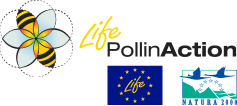Life PollinAction
PUBLIC AWARENESS AND DISSEMINATION OF RESULTS
E.1
Communication and dissemination
What will LIFE PollinAction do:
support to active conservation actions through communication and dissemination activities which include: event organisation; website, social network, brochures, notice boards, video clips and other artwork; educational and technical manuals; environmental education, both in school and extracurricular, and technical training (with farmers, beekeepers, agricultural technicians) activities..
Who is responsible for the action: ALBATROS S.r.l.
Which partners will collaborate: all other partners
Expected results: explication of the problems addressed by the project; Raising awareness through environmental education activities; stakeholder engagement; dissemination of the results of D and E actions.
When: September 2020 – March 2025
Documents available for download: leaflet on the project, teaching guidelines for primary school, textbooks for primary school, technical guidelines on the creation and management of habitats for pollinators, video clips, Layman’s Report.
E.2
Networking with other LIFE and/or non-LIFE projects
What will LIFE PollinAction do: sharing of technical and scientific knowledge, experiences and documents on the issues addressed by the project. This will be achieved though the organization of meetings, conferences, seminars and visits to the respective project sites. In addition, links to other similar initiatives and projects will be established on the project website, news from other projects will be disseminated on the project’s social networks.
Who is responsible for the action: Ca’ Foscari University of Venice
Which partners will collaborate: All the other partners
Expected results: exchange of technical solutions for implementing habitat creation and/or restoration actions; implementation of Green Infrastructure; methods for assessing ecosystem status and services; methods for developing payment for ecosystem service schemes and close to market solutions; stakeholder engagement strategies. Contribution to the implementation of Action E3.
When: September 2020 – March 2025
Documents available for download: –
Projects from friends: http://www.magredinatura2000.it; https://www.life4pollinators.eu/
E.3
Replication and Transfer
What will LIFE PollinAction do: this action aims to increase the impact of the project, through the transfer and replication of good practices and effective methodologies used by the project in other geographical areas and with other stakeholders, in synergy with communication (E1) and networking (E5) activities. According to the strategy defined in the Transfer and Replication Plan, the transfer and replication of both theoretical and technical issues addressed by the project as well as of the skills and expertise gained during the first years of the project, will be based on the sharing of the Technical Guidelines. Technical Guidelines will be shared through focus groups involving three different stakeholder categories: farmer, road infrastructure managers, and municipalities. Results from farmers’ focus groups will also provide information to implement actions E4 (circular economy and “close to market” solutions) and E5 (agri-environmental policy at regional level).
Who is responsible for the action: EcorNaturaSì
Which partners will collaborate: All the other partners
Expected results: further stakeholder engagement; enlargement of the impact of the project to other geographical areas.
When: January 2021 – December 2024
Documents available for download: –
E.4
Circular economy processes and close-to-market solutions
What will LIFE PollinAction do:
designing of circular economy processes (production chains of hay or “green hay” from species-rich donor grasslands) and close-to-market solutions (validation and valorization of short food supply chains; honey and milk) to boost farmer competitiveness and foster sustainable growth, with the engagement of both public entities/policymakers, and private companies.
Who is responsible for the action: Friuli-Venezia Giulia region
Which partners will collaborate: CITA, RV, UNIVE, VA
Expected results: development of three supply chains: a) seed and hay/green hay line from species-rich donor grasslands (Italy); b) hay line for sheep, goats, horses and cattle rearing to produce quality dairy products (Italy); c) honey line to link meadow management and pollination to increase the value of the final product and the meadows from which it is obtained (Spain); design of tools useful for the valorization of agricultural products (brands, transparency of the production system and traceability systems); setting up of a web portal of species-rich grasslands to give visibility to companies and managers of species-rich grasslands allowing them to contact end users of hay (breeders), wild seed mixtures (to be used for environmental restoration and bioengineering) and nectariferous plant species (beekeepers);
When: January 2021 – December 2024
Documents available for download: –
E.5
Implementation of agri-environmental regional policies for local landholders and users
What will LIFE PollinAction do: aims to define agro-ecological policies and identify specific economic instruments to support the restoration and/or creation of habitats for pollinators and promote the adoption by stakeholders of agronomic practices and agro-environmental schemes that take into account the needs of pollinators.
Who is responsible for the action: Veneto region
Which partners will collaborate: ECOR, FVG, UNIVE, VA
Expected results: development of a core of indicators related to pollinating insects in agriculture useful in the evaluation of agronomic practices and agro-environmental schemes, using the results of Action D2; development of incentives to support the creation and maintenance of habitats for pollinators in regional/national agricultural policy.
When: July 2021 – December 2024
Documents available for download: –
E.6
Implementation of urban planning compensation measures
What will LIFE PollinAction do: aims to replace generic greening measures in urban areas with others that are more focused on increasing landscape heterogeneity and creating habitats for pollinators. This is a pilot action that aims to concretely demonstrate to public institutions how to enhance natural and semi-natural environments in an urban setting thereby increasing the ecosystem services they provide, including pollination.
The action will be implemented in synergy with actions C3 and C4 and will use action E1 for its dissemination.
Who is responsible for the action: Caldogno municipality
Which partners will collaborate: UNIVE, VA
Expected results: introduce measures to include habitats for pollinators into urban planning.
When: July 2022 – June 2023
Documents available for download: –

